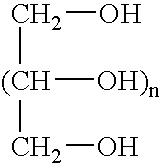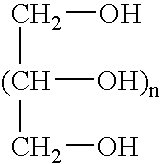It has been found by the present inventors that in order to obtain the full
advantage of the invention, the spinning conditions must be carefully adjusted. Generally speaking, the hydrophobicity of the fibre and consequently of the non-woven material suffers if the fibre is too highly degraded. On the other hand, if the degradation is too low, the fibres tend to have poor thermobonding properties as well as poor processability on the spinning line. The degradation of the
polymer depends on the content of stabilizers in the polyolefin-containing material, the temperature of the extruder and the speed and temperature of the
quenching air. A means to determine the level of degradation of the as-spun fibres is to measure the melt flow rate (MFR) of the fibre and compare this with the MFR of the initial polymeric material. In a preferred embodiment of the present invention the MFR of the as-spun fibres is between 1.5 and 7 times the MFR of the
raw material, typically between 2 and 5 times the MFR of the
raw material. It should be noted however, that this is to a certain extent dependent upon the MFR of the
raw material. Thus, the preferred ratio between fibre MFR and raw material MFR will often be slightly lower for a raw material with a relatively high MFR, e.g. 3-5 times for a raw material with an MFR of 10-15 and 2-4 times for a raw material with an MFR of 15-25.
, the spinning conditions must be carefully adjusted. Generally speaking, the hydrophobicity of the fibre and consequently of the non-woven material suffers if the fibre is too highly degraded. On the other hand, if the degradation is too low, the fibres tend to have poor thermobonding properties as well as poor processability on the spinning line. The degradation of the
polymer depends on the content of stabilizers in the polyolefin-containing material, the temperature of the extruder and the speed and temperature of the
quenching air. A means to determine the level of degradation of the as-spun fibres is to measure the melt flow rate (MFR) of the fibre and compare this with the MFR of the initial polymeric material. In a preferred embodiment of the present invention the MFR of the as-spun fibres is between 1.5 and 7 times the MFR of the raw material, typically between 2 and 5 times the MFR of the raw material. It should be noted however, that this is to a certain extent dependent upon the MFR of the raw material. Thus, the preferred ratio between fibre MFR and raw material MFR will often be slightly lower for a raw material with a relatively high MFR, e.g. 3-5 times for a raw material with an MFR of 10-15 and 2-4 times for a raw material with an MFR of 15-25.
An example of a
general method to regulate the ratio between the MFR of the as-spun fibres and the MFR of the raw material is as follows. The fibre MFR is measured at conditions that allow stable spinning, and this value is compared to the MFR of the
polymer raw material. If the MFR of the spun fibre is higher than desired in relation to the raw material MFR, the fibre MFR is decreased by reducing the temperature of the extruder and / or by increasing the velocity of the quench air. Conversely, if the
fiber MFR is too low, the extruder temperature should be raised and / or the velocity of the quench air lowered.
The stretching process typically involves a series of hot rollers and a
hot air oven. The filaments pass first through one set of rollers, followed by passage through a
hot air oven, and then passage through a second set of rollers. Both the hot rollers and the
hot air oven typically have a temperature of about 50-140.degree. C., e.g. about 70-130.degree. C., the temperature being chosen according to the type of fibre, e.g. typically 115-135.degree. C. for
polypropylene fibres, 95-105.degree. C. for
polyethylene fibres, and 110-120.degree. C. for
polypropylene /
polyethylene bicomponent fibres. The speed of the second set of rollers is faster than the speed of the first set, and hence the heated filaments are stretched accordingly. A second oven and a third set of rollers can also be used (two-stage stretching), with the third set of rollers having a higher speed than the second set. Similarly, additional sets of rollers and ovens may be used. The
stretch ratio is the ratio between the speed of the last and the first set of rollers. The fibres of the present invention are typically stretched using a
stretch ratio of from about 1.05:1 to about 6:1, e.g. from 1.05:1 to 2:1 for
polypropylene fibres, and from 2:1 to 4.5:1 for
polyethylene fibres and polypropylene / polyethylene bicomponent fibres, resulting in an appropriate
fineness, i.e. about 1-7 dtex, typically about 1.5-5 dtex, more typically about 1.6-3.4 dtex, e.g. 1.7-3.3 dtex.
After stretching, the bundles of filaments are treated with the second spin finish, for example using lick rollers or by spraying or dipping.
The stretched fibres are normally texturized (crimped) in order to make the fibres suitable for
carding by giving them a "wavy" form. An effective texturization, i.e. a relatively large number of crimps in the fibres, allows for high proccessing speeds in the
carding machine, e.g. at least 80 m / min, typically at least 150 m / min or even 200 m / min or more, and thus a
high productivity.
 Login to View More
Login to View More 


